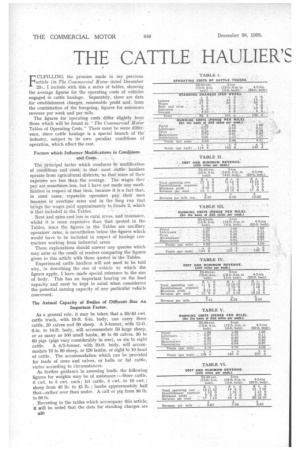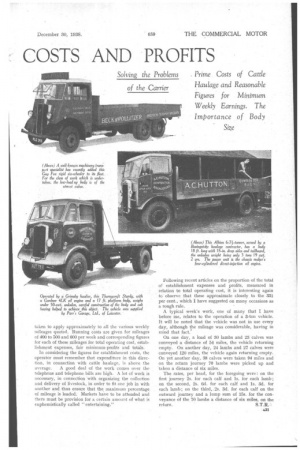THE CATTLE HAULIER'S COSTS AND PROFITS
Page 32

Page 33

If you've noticed an error in this article please click here to report it so we can fix it.
Prime Costs of Cattle Haulage and Reasonable Figures for Minimum Weekly Earnings. The Importance of Body
Size
FULFILLING the promise made in my previous article (in The Commercial Afotor dated December 23), I include with this a series of tables, showing the average figures for the operating costs of vehicles engaged in cattle haulage. Separately, there are data for establishment charges, reasonable profit and, from the combination of the foregoing, figures for minimum revenue per week and per mile.
The figures for operating costs differ slightly from those which will be found in "The Commercial Motor Tables of Operating Costs." There must be some difference, since cattle haulage is a special branch of the industry, subject to its own peculiar conditions of operation, which affect the cost.
Factors which Influence Modifications in Conditions . -and Costs.
The principal factor which conduces to modification of conditions and costs, is that . most Cattle hauliers operate from agricultural districts, so that some of their expenses are less than the average. The wages they pay are sometimes less, but I have not made any modifi'r-ition in respect of that item, because it is a fact that, in most cases, reputable operators pay their men bonuses or overtime rates and in the long run that brings the wages paid approximately to Grade 2, which is that included in the Tables.
Rent and rates cost less in rural areas, and insurance, whilst it is more expensive than that quoted in the Tables, since the figures in the Tables are ancillary operators' rates, is nevertheless below the figures which would have to be included in respect of haulage contractors working from industrial areas.
These explanations should answer any queries which may arise as the result of readers comparing the figures given in this article with those quoted in the Tables.
Experienced cattle hauliers will not need to be told why, in describing the size of vehicle to which the figures apply. I have made special reference to the size of body. This has an important bearing on the load capacity and must be kept in mind when considering the potential earning capacity of any particular vehicle concerned.
The Animal Capacity of Bodies of Different Size An Important Factor.
As a general rule, it may be taken that a 30/40 cwt. cattle truck, with 10-ft. (I-in, body, can carry three cattle, 20 calves and 30 sheep. A 3-tonner, with 12-ft. 6-in. to 14-ft. body, will accommodate 50 large sheep, or as many as 100 small lambs, 40 to 60 calves, 30 to 60 pigs (pigs vary considerably in size), or six to eight cattle. A 4/5-tonner, with 20-ft. body, will accommodate 70 to 80 sheep, or 120 lambs, or eight to 10 head of cattle. The accommodation which can be provided for loads of cows and calves, or bulls or fat cattle, varies according to circumstances.
As further guidance in assessing loads, the following figures for weights may be of assistance :-Store cattle, 6 cwt. to 8 cwt. each; fat cattle, 8 cwt. to 10 cwt.: sheep from 40 lb. to 45 lb. ; lambs approximately half that-rather over than under. A calf or pig from 80 lb, to 90 lb.
. Reverting to the tables which accompany this article, it will be noted that the data for standing charges are 4,40
taken to apply approximately to all the various weekly mileages quoted. Running costs are given for mileages of 400 to 500 and 600 per week and corresponding figures for each of these mileages for total operating cost, establishment expenses, fair minimum-profits and totals.
In considering the figures for establishment costs, the operator must remember that expenditure in this direction, in connection with cattle haulage, is above the average. A good deal of the work comes over the telephone and telephone bills are high. A lot of work is necessary, in connection with organizing the collection and delivery of livestock, in order to fit one job in with another and thus ensure that the maximum percentage, of mileage is loaded: Markets have to be attended and there must be provision for a certain amount of what is euphemistically called "entertaining." Following recent articles on the proportion of the total of establishment expenses and profits, measured in relation to total operating cost, it is interesting again to 'observe that these approximate closely to the 33i per cent., which I have suggested on many occasions as a rough rule. A typical week's work, one of many that I have before me, relates to the operation of a 3-ton vehicle. It will be noted that the vehicle was not in use every day, although the mileage was considerable, having in mind that fact..
On one day, a load of 30 lambs and 23 calves was conveyed a distance of 54 miles, the vehicle returning empty. On another day, 24 lambs and 27 calves were conveyed 120 miles, the vehicle again returning empty. On yet another day, 38 calves were taken 94 miles and on the return journey 70 lambs were picked up and 'taken a distance of six miles.
The rates, per head, for the foregoing were: on the first journey 2s. for each calf and is. for each lamb; on the second, 2s. 6c1. for each calf and 1s. 3d. for each lamb; on the third, 2s. 3d. for each calf on the outward journey and a lump sum of 15s. for the conveyance of the 70 lambs a distance of six miles, on the return.












































































